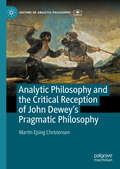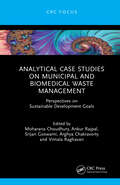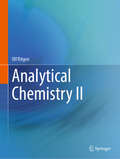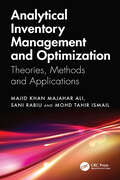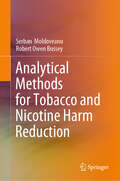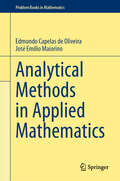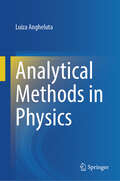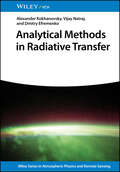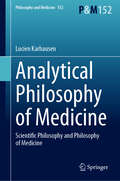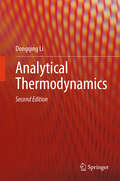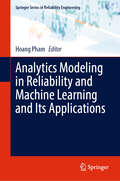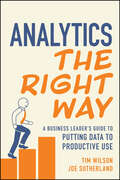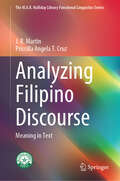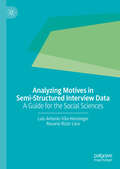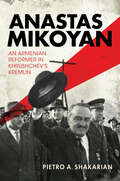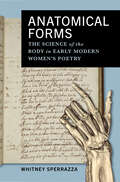- Table View
- List View
Analytic Philosophy and the Critical Reception of John Dewey’s Pragmatic Philosophy (History of Analytic Philosophy)
by Martin Ejsing ChristensenThis book examines the critical reception of Dewey&’s pragmatic philosophy by six prominent analytic philosophers and relates it to the contested history of analytic philosophy and Deweyan pragmatism. It argues that analytic philosophers&’ critical reception of Dewey&’s pragmatist philosophy has, from the very beginning, been marred by externalist readings that do not engage with Dewey&’s thinking from the inside, and suggests that this throws doubt upon the new revisionary histories of analytic philosophy and Deweyan pragmatism according to which the marginalization of Dewey&’s pragmatism represents the sensible result of critical processes of reasoning. At the same time, however, the book also points out that Dewey and his analytic critics in fact share several worries and suggests that these common concerns might serve as points of reference for more fruitful dialogues across the traditions of analytic philosophy and Deweyan pragmatism in the future.
Analytical Case Studies on Municipal and Biomedical Waste Management: Perspectives on Sustainable Development Goals
by Srijan Goswami Moharana Choudhury Arghya Chakravorty Ankur Rajpal Vimala RaghavanEffective waste management practices are essential to mitigate unfavourable impacts and achieve the Sustainable Development Goals. This book covers perspectives addressing the Sustainable Development Goals through analytical and case studies on municipal and biomedical waste management. It consists of ten selectively curated highly technical chapters covering various aspects of achieving the Sustainable Development Goals through applying effective waste management strategies and practices through practical case studies and examples.Features: Analysis of over 30 real-life case studies reviewed from local as well as global perspectives Discusses application of technologies in real time Addresses the 17 Sustainable Development Goals at ground level Covers a broad range of case studies on municipal solid waste and biomedical waste treatment and management Reviews the latest evidence-based approach in diagnosis and management This book is aimed at researchers and graduate students in environmental engineering and management.
Analytical Chemistry II
by Ulf RitgenThis workbook takes you through the successful textbook Skoog/Holler/Crouch, Instrumentelle Analytik and is designed primarily for self-study.In five parts, the lecture content of more advanced analytical chemistry is summarized and explained using selected examples: mass spectrometry and nuclear magnetic resonance spectroscopy deal with the investigation of molecules, and numerous electroanalytical methods such as potentiometry, coulometry, amperometry and voltammetry are also covered. An overview of more specialized analytical methods includes the use of radioactive substances and various fluorescence methods, as well as methods of information acquisition in the increasingly important electrochemical and optical sensor technology and their automation. The course concludes with a summary of various principles and application methods of statistics, which are simply indispensable in the context of analytics. In order to facilitate independent learning, references to essential sections and illustrations of the textbook are made throughout the book.Not least because of the numerous examples, the book, which is aimed at students of chemistry or related scientific subjects, provides an easy-to-understand introduction to more complex aspects of analytical chemistry. In direct continuation of the workbook Analytical Chemistry I, references are made again and again to already known basics from other courses, which facilitate the linking of the familiar and the new. Learning with this workbook has been tested in a distance learning chemistry course and facilitates preparation for module examinations in more advanced analytical chemistry.This book is a translation of the original German 1st edition Analytische Chemie II by Ulf Ritgen, published by Springer-Verlag GmbH Germany, part of Springer Nature in 2020. The translation was done with the help of artificial intelligence (machine translation by the service DeepL.com). A subsequent human revision was done primarily in terms of content, so that the book will read stylistically differently from a conventional translation. Springer Nature works continuously to further the development of tools for the production of books and on the related technologies to support the authors.
Analytical Dynamics of Nonlinear Rotors (Nonlinear Physical Science)
by Albert C. Luo Yeyin Xu Jianzhe HuangThis book is a monograph about the analytical dynamics of nonlinear rotor systems. The analytical solutions of periodic motions in nonlinear rotor systems are presented in this book. To help one understand the analytical solutions, the generalized harmonic balance method for periodic motions in polynomial nonlinear systems is briefly reviewed first, and then the semi-analytical method for periodic motions in any nonlinear systems is presented briefly too, which is also called the implicit mapping method. Such two analytical methods are employed to determine the solutions of periodic motions in nonlinear rotor systems. The analytical expressions of periodic motions to chaos for nonlinear rotor systems are presented, and the frequency-amplitude characteristics of nonlinear rotor systems are discussed. In addition, the accurate modeling of nonlinear rotors with oil films is presented, and the periodic motions of such fully nonlinear oil-film rotor systems are developed through the semi-analytical method. This book provides a better understanding of frequency-amplitude characteristics in nonlinear rotor systems. The methodology presented in this book can help one study complicated nonlinear rotor systems.
Analytical Inventory Management and Optimization: Theories, Methods and Applications
by Majid Khan Majahar Ali Sani Rabiu Mohd Tahir IsmailIn this vital resource with discussion of and applicability to various industries, Ali, Rabiu, and Ismail guide readers through the challenging environment of inventory management and enable them to successfully balance the demand and supply of items in stock, a critical task in any field.The book covers a wide range of topics related to inventory management and optimization. After introducing the key concepts and principles of inventory management, such as inventory analytics, optimization, and models, the authors provide a comprehensive and in-depth understanding of various inventory control techniques that are essential for effective inventory management, such as ABC analysis, EOQ model, safety stock, and reorder point. They then introduce various mathematical models and optimization techniques such as system-level and item-level inventory analysis and show how to perform sensitivity analyses to test the robustness of these models. They then look at the role of inventory management in various industries such as supply chain management and logistics, manufacturing, and more; and address the effects and integration of cutting-edge technologies like artificial intelligence, machine learning, and robotics to conventional inventory management practices. Additional topics include inventory forecasting, inventory management systems, inventory auditing and control, risk management. In combining mathematical underpinnings in the area with practical case studies throughout, readers will gain a solid understanding of the real-world applications of these different techniques so that they can apply inventory management and optimization best practices in their workplace.The comprehensive coverage makes the book a valuable reference for practitioners and students, particularly postgraduate and MBA students, who require such insights to improve business functions and make informed decisions. Because it provides the foundational mathematical knowledge required to comprehend any chapter, it is also accessible for readers without a strong background in mathematics.
Analytical Isotope Geochemistry: Techniques and Data Interpretation (Advances in Isotope Geochemistry)
by Gyana Ranjan TripathyIsotopes of radiogenic and non-traditional stable elements have been extensively used for quantitative understanding of earth, planetary, ocean, and climatic processes. More recently, these applications have also been extended to medical, petroleum, forensic, and archaeological sciences. The proposed book aims at providing thorough analytical details for precise (ppm-level) isotopic measurements using state-of-the-art mass spectrometers (e.g., IRMS, TIMS, MC-ICPMS). All essential details on sample handling, chromatographic/solvent-extraction purification, isobaric interferences, spike-sample equilibration, data corrections, and measurement statistics for different isotopes have been reviewed here. It will also provide (i) information on recent technical analytical developments and (ii) &“do's-and-don'ts&” for analyzing isotopic ratios precisely. This book serves as an excellent handbook to set up these systematics with proper scientific rigor in academic and industrial laboratories.
Analytical Methods for Tobacco and Nicotine Harm Reduction
by Serban Moldoveanu Robert Owen BusseyThis book presents a critical review of the analytical methods used for the measurement of harmful and potentially harmful compounds (HPHC) in tobacco and nicotine-related products. In the first chapter of the book, a presentation of the main types of tobacco products is introduced, including cigarettes, cigars, cigarillos, little filter cigars, dissolvable tobacco products, hookah (shisha or waterpipe), nicotine gels, pipe tobacco products, roll your own, smokeless tobacco products, such as dip, snuff, snus, and chewing tobacco and E-Cigarettes, vapes, and other electronic nicotine delivery systems (ENDS). In the second and main part of the book, the analytical methods for the compounds in the established list from the U.S. Food and Drug Administration (FDA) of HPHC are discussed. For example, in cigarette smoke, specific discussions related to the analytical methods for nicotine, acetaldehyde, acrolein, acrylonitrile, aromatic amines, ammonia, benzene, benzo[a]pyrene, 1,3-butadiene, carbon monoxide, crotonaldehyde, formaldehyde, isoprene, TSNA&’s, and toluene are presented. Specific analytical methods for the analysis of HPHC in ENDS are also included. Various other analytical methods used for all the 93 HPHC in the established list by FDA for tobacco products and tobacco smoke are presented. The book will be useful to scientists working in the industry as well as students and researchers interested in the area.
Analytical Methods in Applied Mathematics (Problem Books in Mathematics)
by Edmundo Capelas de Oliveira José Emílio MaiorinoThis book compiles an extensive list of solved and proposed problems in mathematical topics in analysis, aimed at students of mathematics, applied mathematics, physics, and engineering. The book begins with an exploration of simple linear and nonlinear ordinary differential equations in Chapter 1, advancing through topics such as power series and the Frobenius method for solving differential equations in Chapter 2. In subsequent chapters, the discussion expands to include functions of complex variables, special functions constructed through the hypergeometric function, and series solutions including Fourier, Fourier-Bessel, and Fourier-Legendre series. Problems in integral transforms, Sturm-Liouville systems, Green's function, linear partial differential equations are also included. The work finishes with a special chapter on fractional calculus and practical applications of the topics presented. With solved examples and step-by-step exercises, this book can be of value to undergraduate and graduate students seeking a hands-on approach on the listed topics, and as a bibliographical complement to STEM courses as well.
Analytical Methods in Physics
by Luiza AnghelutaThis textbook is based on lectures for a third-year course on mathematical methods in physics taught in the Department of Physics at the University of Oslo. This textbook contains 26 lectures organized into five topics: i) Complex Analysis, ii) Variational Calculus, iii) Ordinary Differential Equations, iv) Integral Transformations, and v) Partial Differential Equations. For each topic, basic fundamental theorems and mathematical techniques are introduced and applied to solving problems. This resource is intended as concise and well-structured, making it suitable for a one-semester course. It is aimed at second- or third-year undergraduate students with background in mathematics and physical science.
Analytical Methods in Radiative Transfer (Wiley Series in Atmospheric Physics and Remote Sensing)
by Dmitry Efremenko Alexander Kokhanovsky Vijay NatrajProvides in-depth knowledge of the physics of radiative transfer In Analytical Methods in Radiative Transfer, a team of distinguished researchers delivers a comprehensive exploration of solutions to practical problems of modern atmospheric optics related to solar light interaction with the terrestrial atmosphere and the remote sensing of clouds, aerosols, and gases. The authors describe analytic methods in radiative transfer that help explain atmospheric phenomena. The book includes discussions on the interaction of solar light with the atmosphere. Readers will also benefit from thorough reviews of various analytical radiative transfer techniques, for various turbid media, including media with phase functions extended in the forward direction, and also semi-infinite, non-absorbing, weakly absorbing, and strongly absorbing light scattering media. Analytical Methods in Radiative Transfer also includes: A thorough introduction to exact solutions of the radiative transfer equation, including situations of single scattering, as well as isotropic and Rayleigh scattering A comprehensive exploration of approximate solutions for scalar radiative transfer, including single and multiple light scattering separation and the case of semi-infinite media such as snow In-depth examinations of the applications of analytical methods in atmospheric radiative transfer, including aerosol remote sensing, cloud remote sensing, and the remote sensing of trace gases Perfect for meteorologists, climatologists and graduate students studying physics, Analytical Methods in Radiative Transfer is also an indispensable resource for geophysicists seeking a practical exploration of modern atmospheric optics.
Analytical Philosophy of Medicine: Scientific Philosophy and Philosophy of Medicine (Philosophy and Medicine #151)
by Lucien KarhausenThis book describes the philosophy of medicine as a subset of the philosophy of science. It is grounded in an epistemological bottom-up account that arises from the clinical situation, the epidemiologic and the resulting public health account. The volume offers a set of coherent beliefs that are deductively closed, which means that any statement which is logically entailed by the theory belongs to the theory. Medicine does not originate, as usually admitted, with the notion of disease inasmuch as concepts of disease, malfunction or health are evolved, sophisticated and advanced constructs. Medical norms, i.e., pathological features, are logically and conceptually prior to normal features. Following Ludwig Wittgenstein, by analogy with the way members of a family resemble each other, diseases are often what Ludwig Wittgenstein called “family-resemblance concepts”, which manifest a similarity shared by things classified into certain groups in the way members of a family resemble each other: each shares characteristics which many but not all the others, and there are no necessary or sufficient conditions for belonging in that classification. This book analyses the confusions associated with the concept of health, and subsequently turns to medical interventions, preventive, therapeutic and palliative as well as to the caring relationship, patients’ autonomy, doctors’ authority, and paternalism. Finally, the epistemic, ethical, or ontological limits of medicine, are being discussed, and the final account leaves us at the end of the scale with the perspective afforded by the patient facing suffering, impairment, death and tragedy, not to mention the physician’s predicament, which give rise to the principle that undergirds them all, i.e., the value of life.
Analytical Techniques and Methods for Biomass
by Silvio Vaz Jr.This book deals with the application of techniques and methods of chemical analysis for the study of biomass and its conversion processes. It aims to fill the existing gap in the literature on this subject. The application of various techniques and analytical methods is presented straightforwardly, enabling readers to choose the most appropriate methodologies for analyzing the major classes of plant biomass and their products. Modern chemistry plays a crucial economic role in industrial activities based on biomass. There is an increasing emphasis on its application, specifically in the development of biorefineries, and the principles of green chemistry allow effective use of biomass while significantly reducing environmental impact. In this context, analytical chemistry can contribute significantly to the supply chains of biomass, be it plant or animal origin. However, biomass from plant sources presents both the greatest challenges and the highest opportunity for technical, scientific, and economic progress due to its diverse chemical constitution. Chemical analysis can be used to examine the composition of biomass, characterize its physicochemical properties, and monitor their conversion processes. This approach can enhance the quality of products derived from biomass and expand their potential applications. The quality of the biomass used determines the product quality. Therefore, reliable information about the chemical composition of the biomass to establish the best use which will influence harvest and preparation steps is essential. Accordingly, this book includes contributions from select international experts who discuss key aspects of biomass structure, their physical and chemical properties, the parameters of conversion processes, the products and by-products formation and quantification, and quality parameters.
Analytical Thermodynamics
by Dongqing LiThis second edition presents an enriched and expanded exploration of the fundamental principles of thermodynamics tailored for graduate-level studies. Drawing on over three decades of academic teaching experience, the author has refined the content, making it more accessible and comprehensive. Chapter 1 has been restructured for clarity, delineating "Legendre Transformation" and "Thermodynamic Potentials" into separate sections, while the treatment of "Chemical Potentials" has been significantly augmented, encompassing two-component ideal gas mixtures and a re-derivation of chemical potentials for dilute solutions. Additionally, the section on thermodynamic stability now boasts enhanced explanations and illustrative figures. Chapter 2 introduces a groundbreaking section, "Electrolyte Solution in Electric Field as a Non-Uniform System," providing fresh insights into unexplored realms. Chapter 3, now enriched with several new sections, delves into topics such as "Contact Angles on Heterogeneous Surfaces and Rough Surfaces," "Elastic Liquid-Fluid Interface," "Curvature Effect on Surface Tension," "Solute Effect on Equilibrium Pressure," and "Heterogeneous Bubble Nucleation in a Dilute Solution." Chapter 4 features new elucidations and discussions aimed at bolstering comprehension, while the entirely new Chapter 5 offers solutions to selected homework and exam questions, adding a practical dimension to the theoretical framework. This edition, encompassing approximately 50% new content, expands the book by 131 pages, rendering it an even more invaluable resource for professors instructing advanced thermodynamics and graduate students delving into this intricate subject matter.
Analytical and Approximate Methods for Complex Dynamical Systems (Understanding Complex Systems)
by Alexander TimokhaThis book presents Analytical and Approximate Methods for Complex Dynamical Systems and introduces ideas of discontinuous mapping treated as complex dynamical systems. Mathematicians of world-recognized Ukrainian scientific schools established by M.Krylov, M.Bogolyubov, Yu.Mitropolskiy, and A.Sharkovsky used to cooperate for writing the collective book whose purpose consists of illustrating a synergy of combining diverse (by idea and technique) constructive analytical and approximate approaches and methods in complex dynamical systems which are herein associated with mathematical models of networks, conflict/economic theories, sloshing, soft matter, and even levitating drops. Readers are facilitated to learn contemporary insights, fundamentals (Parts I and III), applications (Part II), and components of theories of bifurcation, synchronization/self-organization, collective dynamics, chaos, solitons, fractional differential equations, symmetry, reduced order modelling, and many others, that makes the book useful for both graduate and postgraduate students, lecturers, researchers, and even engineers dealing with multidimensional dynamic systems.
Analytical and Stochastic Modelling Techniques and Applications: 28th International Conference, ASMTA 2024, Venice, Italy, June 14, 2024, Proceedings (Lecture Notes in Computer Science #14826)
by András Horváth Arnaud Devos Sabina RossiThis book constitutes the refereed proceedings of the 28th International Conference on Analytical and Stochastic Modelling Techniques and Applications, ASMTA 2024, held in Venice, Italy, on June 14, 2024. The 10 full papers presented were carefully reviewed and selected from 14 submissions. These papers covered a wide range of topics in analytical and stochastic modeling techniques and their applications.
Analytics Modeling in Reliability and Machine Learning and Its Applications (Springer Series in Reliability Engineering)
by Hoang PhamThis book presents novel research and application chapters on topics in reliability, statistics, and machine learning. It has an emphasis on analytical models and techniques and practical applications in reliability engineering, data science, manufacturing, health care, and industry using machine learning, AI, optimization, and other computational methods. Today, billions of people are connected to each other through their mobile devices. Data is being collected and analysed more than ever before. The era of big data through machine learning algorithms, statistical inference, and reliability computing in almost all applications has resulted in a dramatic shift in the past two decades. Data analytics in business, finance, and industry is vital. It helps organizations and business to achieve better results and fact-based decision-making in all aspects of life. The book offers a broad picture of current research on the analytics modeling and techniques and its applications in industry. Topics include: l Reliability modeling and methods. l Software reliability engineering. l Maintenance modeling and policies. l Statistical feature selection. l Big data modeling. l Machine learning: models and algorithms. l Data-driven models and decision-making methods. l Applications and case studies in business, health care, and industrial systems. Postgraduates, researchers, professors, scientists, engineers, and practitioners in reliability engineering and management, machine learning engineering, data science, operations research, industrial and systems engineering, statistics, computer science and engineering, mechanical engineering, and business analytics will find in this book state-of-the-art analytics, modeling and methods in reliability and machine learning.
Analytics the Right Way: A Business Leader's Guide to Putting Data to Productive Use
by Tim Wilson Joe SutherlandCLEAR AND CONCISE TECHNIQUES FOR USING ANALYTICS TO DELIVER BUSINESS IMPACT AT ANY ORGANIZATION Organizations have more data at their fingertips than ever, and their ability to put that data to productive use should be a key source of sustainable competitive advantage. Yet, business leaders looking to tap into a steady and manageable stream of “actionable insights” often, instead, get blasted with a deluge of dashboards, chart-filled slide decks, and opaque machine learning jargon that leaves them asking, “So what?” Analytics the Right Way is a guide for these leaders. It provides a clear and practical approach to putting analytics to productive use with a three-part framework that brings together the realities of the modern business environment with the deep truths underpinning statistics, computer science, machine learning, and artificial intelligence. The result: a pragmatic and actionable guide for delivering clarity, order, and business impact to an organization’s use of data and analytics. The book uses a combination of real-world examples from the authors’ direct experiences—working inside organizations, as external consultants, and as educators—mixed with vivid hypotheticals and illustrations—little green aliens, petty criminals with an affinity for ice cream, skydiving without parachutes, and more—to empower the reader to put foundational analytical and statistical concepts to effective use in a business context.
Analytics, Machine Learning, and Artificial Intelligence: Second Analytics Global Conference, AGC 2024, Kolkata, India, March 6–7, 2024, Revised Selected Papers (Communications in Computer and Information Science #2224)
by Chandan Mazumdar Suparna Dhar Sanjay Goswami Indranil Bose Rameshwar Dubey Dinesh Kumar Unni KrishnanThis book constitutes the refereed proceedings of the Second Analytics Global Conference on Analytics, Machine Learning, and Artificial Intelligence, AGC 2024, held in Kolkata, India, during March 6-7, 2024. The 15 full papers and 3 short papers presented in these proceedings were carefully reviewed and selected from 60 submissions. The papers are organized in these topical sections: applications of analytics in business; analytics methods, tools & techniques.
Analyzing Filipino Discourse: Meaning in Text (The M.A.K. Halliday Library Functional Linguistics Series)
by J. R. Martin Priscilla Angela CruzThis book explores Filipino, the national language of the Philippines, from the perspectives of Critical Discourse Analysis (CDA) and Positive Discourse Analysis (PDA)—informed by Systemic Functional Linguistics (SFL). It is designed to encourage researchers to study Filipino texts—both spoken and written—and to unpack them in a way that clarifies their function in Philippine society. With this goal in mind, the book introduces a number of discourse analysis tools and shows how to apply them to a range of Filipino texts—including a children's picture book story, some mental health advice about coping with COVID-19, President Duterte's speech about the Philippine government's initial response to the COVID-19 pandemic, a comment piece from a student newspaper about problems with online learning modules produced by the Department of Education, and a reflective text about growing up in Davao. This is the first book to draw on a range of functional linguistic tools to analyse Filipino discourse in order to provide deeper insights into the role of language in bilingual education, the linguistic enactment of power, and the importance of thinking across languages when analysing texts. Key issues addressed include the complementarity of CDA and PDA, SFL's model of social context (as register and genre), analysing bilingual texts and bilingual education. The book fosters appliable linguistics as a dialectic of theory, description, and practice—supporting Filipino discourse analysts as they engage with the challenge of giving people access to a range of tools they can use productively to mean and thereby more successfully pursue their social goals. As such, it provides a model for researchers of other languages of how to encourage the analysis of meaning in texts within and beyond the clause. It is relevant to scholars across the spectrum of linguistics, particularly those working in Systemic Functional Linguistics.
Analyzing Motives in Semi-Structured Interview Data: A Guide for the Social Sciences
by Luis Antonio Vila-Henninger Rosario Rizzo LaraThis book advances the emerging work on using semi-structured interview data to analyze motives by providing the first book-length treatment of this underdeveloped methodological area in sociology and social science more broadly. Exploring key methodological and theoretical debates on this topic in-depth, the authors apply a dual-process model approach to demonstrate how we can analyze motives effectively in semi-structured interview data, and in tandem, understand the sociological reasoning behind society's moral judgments and political decision-making. Additionally, the authors develop the accessible and rigorous 5Rs methodology, which synthesizes insights from an array of literatures into a novel, cohesive analytic tool for analyzing motives in semi-structured interview data. Balancing transparency with theoretical nuance, it enables researchers to revisit and reuse previously collected data that may have been considered unsuitable for motive analysis, either because of prevailing disciplinary assumptions, or because of how data were initially framed and coded. Applicable to various cultural contexts and disciplines, the methodology explored in this book is thus of international interest to researchers and students of qualitative sociology, sociology of culture and cognition, migration studies, cognitive science, and moral psychology, with wider implications for qualitative methodologies in the social sciences.
Anansi and the Mango Tree: Independent reading Turquoise 7 (Reading Champion #552)
by Damian HarveyIn this African traditional tale, Anansi wants some of Tiger's mangoes, but Tiger doesn't want to share. Anansi thinks of a clever way to trick Tiger and get some of the mangoes.This story is part of Reading Champion, a series carefully linked to book bands to encourage independent reading skills, developed with Dr Sue Bodman and Glen Franklin of UCL Institute of Education (IOE)Reading Champion offers independent reading books for children to practise and reinforce their developing reading skills.Fantastic stories are accompanied by engaging artwork and a reading activity. Each book has been carefully graded so that it can be matched to a child's reading ability, encouraging reading for pleasure.
Anansi and the Pot: Independent Reading Orange 6 (Reading Champion #534)
by Ann BryantThis story is part of Reading Champion, a series carefully linked to book bands to encourage independent reading skills, developed with Dr Sue Bodman and Glen Franklin of UCL Institute of Education (IOE)In this tale from Africa, Anansi is determined to trick Tiger and steal his food!Reading Champion offers independent reading books for children to practise and reinforce their developing reading skills.Fantastic stories are accompanied by engaging artwork and a reading activity. Each book has been carefully graded so that it can be matched to a child's reading ability, encouraging reading for pleasure. This retelling of the original traditional tale is suitable for children aged 5-7, or those reading at book band Orange.
Anansi and the Tiger in the Pit: Independent Reading Blue 4 (Reading Champion #523)
by Katie WoolleyThis story is part of Reading Champion, a series carefully linked to book bands to encourage independent reading skills, developed with Dr Sue Bodman and Glen Franklin of UCL Institute of Education (IOE)Reading Champion offers independent reading books for children to practise and reinforce their developing reading skills.Fantastic stories are accompanied by engaging artwork and a reading activity. Each book has been carefully graded so that it can be matched to a child's reading ability, encouraging reading for pleasure. This retelling of the original traditional tale is suitable for children aged 5-7, or those reading at book band Blue.
Anastas Mikoyan: An Armenian Reformer in Khrushchev's Kremlin
by Pietro A. ShakarianVeteran Soviet statesman and longtime Politburo member Anastas Ivanovich Mikoyan is perhaps best remembered in both the West and the post-Soviet space as a master political survivor who weathered every Soviet leader from Lenin to Brezhnev. Less well known is the pivotal role that Mikoyan played in dismantling and rejecting the Stalinist legacy and guiding Khrushchev's nationality policy toward greater decentralization and cultural expression for nationalities.Based on new discoveries from the Russian and Armenian archives, Anastas Mikoyan is the first major biographical study in English of a key figure in Soviet politics. The book focuses on the Armenian statesman's role as a reformer during the Thaw of 1953–1964, when Stalin's death and Khrushchev's ascension opened the door to greater pluralism and democratization in the Soviet Union. Mikoyan had been a loyal Stalinist, but his background as a native Armenian guided his Thaw-era reform initiatives on nationality policy and de-Stalinization. The statesman advocated a dynamic approach to governance, rejecting national nihilism and embracing a multitude of ethnicities under the aegis of "socialist democracy," using Armenia as his exemplar. While the Soviet government adopted most of Mikoyan's recommendations, Khrushchev's ouster in 1964 ended the prospects for political change and led to Mikoyan's own resignation the following year. Nevertheless, Mikoyan remained a prominent public figure until his death in 1978.Following a storied statesman through his personal and professional connections within and beyond the Soviet state, Anastas Mikoyan offers important insights into nation-building, the politics of difference, and the lingering possibilities of political reform in the USSR.
Anatomical Forms: The Science of the Body in Early Modern Women’s Poetry (Alembics: Penn Studies in Literature and Science)
by Whitney SperrazzaDemonstrates how early modern women writers such as Margaret Cavendish and Hester Pulter wielded poetics as a tool for scientific workAnatomical Forms excavates the shared material practices of women’s poetic work and anatomical study in early modern England. Asserting that poetry is a dimensional technology, Whitney Sperrazza demonstrates how women writers wielded poetics as a tool for scientific work in order to explore and challenge rapid developments in anatomy and physiology.In the sixteenth and seventeenth centuries, anatomists were actively exploring the best ways to represent bodies in texts—to translate the work of the dissection room into the pages of books. When we recognize Renaissance anatomy as fundamentally a book-making project, Sperrazza insists, we find a complex and expansive history of anatomy in the pages of women’s poetry. Women poets have long been absent from histories of literature and science, but by shifting our focus from content to form, Sperrazza reveals complex engagements with questions on corpse preservation, dissection, obstetrics and gynecology, and skin theory in the poetry of Margaret Cavendish, Aemilia Lanyer, Mary Wroth, Mary Sidney Herbert, and Hester Pulter.Through close formal analysis and original research on early modern anatomy treatises, Anatomical Forms weaves together critical conversations in poetics, book history, the history of science, and women’s writing. Sperrazza challenges her readers to imagine science differently—to understand that science might not always look like we expect it to look—and, in the process, brings into focus a feminist history of poetic form centered on material practice.
